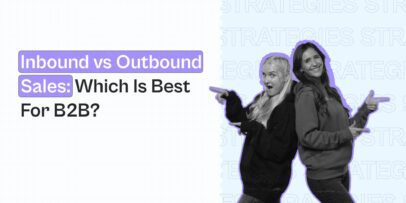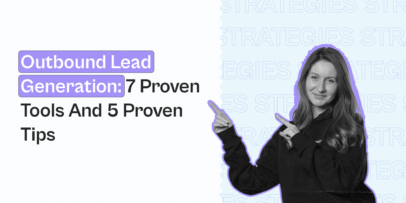LinkedIn Content Strategy: The Ultimate Guide For B2B Sales
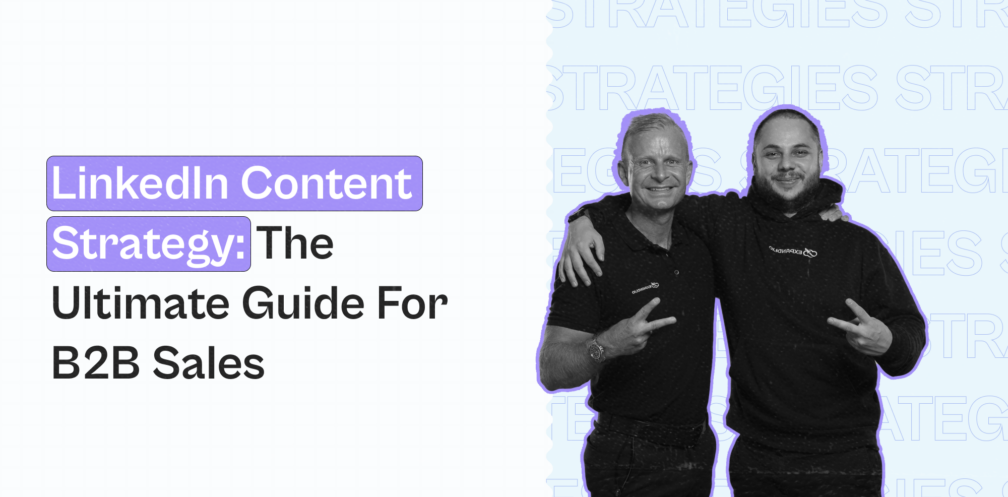
Did you know that more than 55% of decision-makers use LinkedIn content to vet organizations and decide which brands to work with?
Plus, LinkedIn makes up for more than 50% of all social traffic to B2B websites and blogs, with over 3 million users sharing content weekly.
So, how can you use these trends to bring more people to your brand?
There are two main ways to generate leads and eventually boost your sales on LinkedIn:
- You can put in the work, invest in Sales Navigator, A/B test thorough outreach sequences, and experiment with different messaging in your outreach to see what works best.
- Or you can start creating content to attract your ideal customer persona to come to you.
In this guide, we’ll be focusing on the second one – your LinkedIn content strategy.
By the end of this guide, you’ll never run out of content ideas again!
We’ll cover:
- What is a LinkedIn content strategy and why is this important for your brand
- How a solid LinkedIn content strategy can help your B2B sales instead of simply boosting your post views
- How to come up with a unique LinkedIn content strategy for your B2B brand from the ground up
- 10 Successful LinkedIn post ideas and content structures to swipe

Now, we can get this guide to LinkedIn content strategy started!
What Is A Content Strategy For LinkedIn And How Does It Work?
First things first, what is a LinkedIn content strategy, exactly?
It’s a way you approach analyzing, planning, and creating content for your LinkedIn brand, whether it’s your personal profile or company.
You need a specific LinkedIn content strategy based on:
- your target audience,
- marketing goals,
- and the kind of value you’re delivering.
“Posting whenever you feel like” is not a strategy and it won’t get you anywhere.
Done right, you can even generate up to hundreds of leads from a single post on LinkedIn.
As a bonus point, you can even automatically reach out to everyone who commented or liked your post (more on this below).
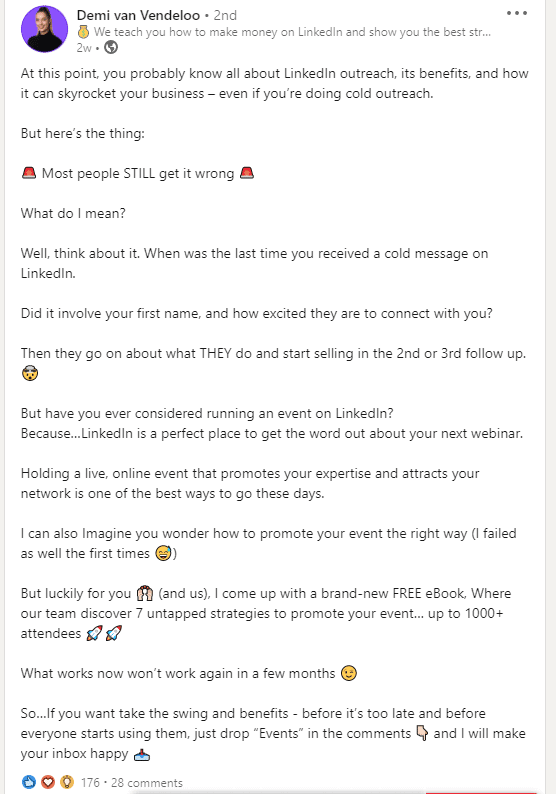
Some common content marketing goals on LinkedIn include:
- Introducing your business to new people
- Improving brand awareness
- Cultivating trust through case studies and expertise posts
- Adding more leads into your sales pipeline
- Building a loyal community of followers
But ultimately, the goal of your content marketing strategy will be to boost your B2B sales.
You can do this across different forms of content, including:
- Delivering value
- Case studies
- Engagement polls
- Networking posts
- Social selling strategies
- And more, depending on your brand
By now, you probably realize there is no “one-size-fits-all” content marketing strategy as everyone’s brand is different.
For example, a technical SaaS owner on LinkedIn and the head of HR will post utterly different content types. But most likely, most of them would like to pull the reader into their inbound marketing funnel.
So, is posting content on LinkedIn worth it for everyone?
Let’s take a look!
3 key elements of a good LinkedIn content strategy for businesses?
There are a few things to consider when setting up a LinkedIn content marketing strategy for your brand.
Defining the audience you’re writing content for
You should have a strong idea of who your targeted audience is regardless of your marketing type.
You need to know who you’re writing for, down to:
- Their company role and seniority
- Their industry
- Their skill level
- Their pain points and needs
- Company size
Not sure who your audience is?
See our article on ideal customer profile vs buyer persona.
You can also divide your audience into stages, including:
- Strangers – Leads who don’t know your brand, company, or content yet.
- Visitors – Visited your site, learned a bit about what you do from your content, know about your brand but not ready to work with you yet.
- Leads – Consume your content, follow your brand, and gave you their email through an opt-in or had a private conversation with you to decide if your offer is relevant to them.
- Customer – Leads who converted and purchased your product or service.
- Promoter – Optional and final step of the content funnel. Depending on the customer, they might become brand advocates and recommend your brand to their colleagues or audiences.
Once you define who you’re writing for, you’ll also have a much better idea of how to approach your content.
You’ll know what words to use, what pain points to target, what topics to discuss, the ‘needs’ and ‘wants’ of the reader, and more.
Fortunately, LinkedIn allows you to see how many people saw your posts, your LinkedIn company pages analytics, and how many people viewed your profile.
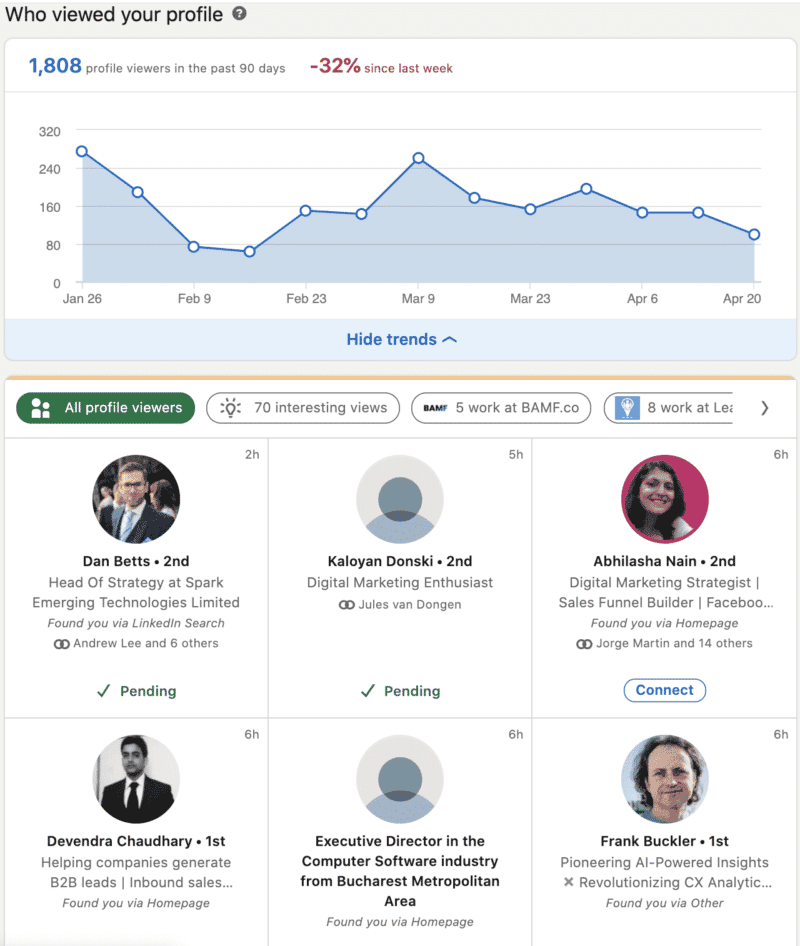
Building authority based on your expertise
One of the best things you can do early on for your content strategy is to define your authority based on your industry expertise.
What does this mean?
Essentially, your content should be centered around topics you are expert in and those that are relevant to your product or service.
Moreover, you should create content for each stage of the customer’s journey.
- Awareness stage – When the reader discovers your company, product, or service. “How-to” type topics are common here to educate the reader and give value.
- Consideration stage – When the reader takes interest in your offer. For example, content about your product or service, narrowing down, and how to make a decision.
- Decision-making stage – When the reader is deciding to buy from you. Finally, why they should work with you, case studies of your previous achievements, pricing, how the process works, and more.
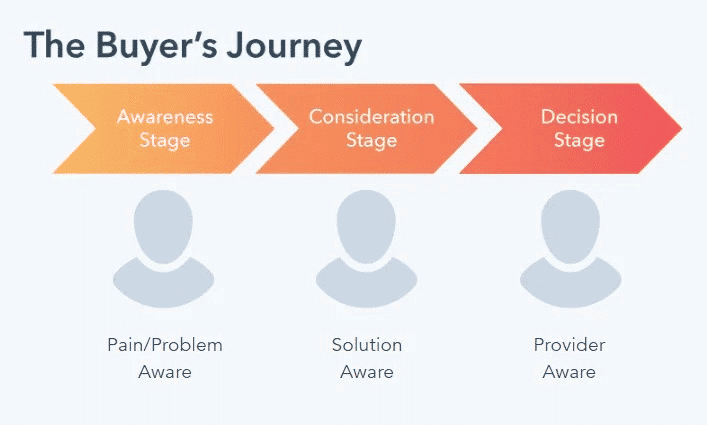
Your main goal is to nurture people in the different stages of the decision-making process.
This is your chance to produce different forms of content across your funnel. As your audience gets more and more familiar with your brand.
Establishing your content strategy goals
A good content strategy should be based on concrete goals. This way, based on data, you know what’s working and what’s not.
While the end goal is to attract clients and boost your B2B sales, you also need to consider your:
- Reach
- Engagement
- Profile views
- Search appearances
- Social selling index
- If you’re doing outreach as well – your connection acceptance and reply rates
- And other sales metrics
As mentioned above, a key point of leveraging a LinkedIn content strategy is boosting your B2B sales.
Here’s how that works.
7 Steps To Create A LinkedIn Strategy For Businesses From The Ground Up (With Examples)
Let’s now consider some actionable steps to build your solid LinkedIn content strategy from the beginning.
1. Outline the ideal customer profile (ICP) and buyer persona
You must define your ideal customer profile (ICP) and buyer persona to be even more specific.
What’s the difference between the two?
- ICP – Fictitious description of an ideal company with all the characteristics of your perfect customer. Mainly used by B2B companies and is created using statistical data from your CRM, analytics tools, and by interviewing your best customers.
- Buyer persona – Semi-fictional representation of your customers. It helps you identify individuals with different job roles and decision-makers behind every purchase. This focuses more on the individuals and decision-makers than on companies.
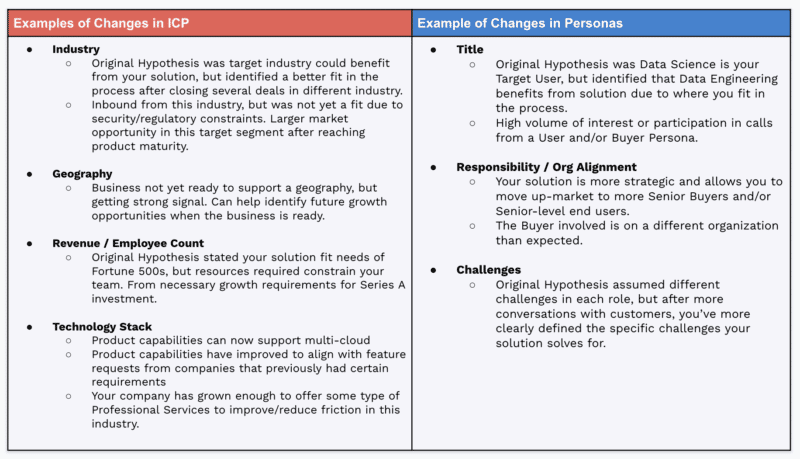
To put this into practice and make sure you’re defining your audience the right way, consider following these steps:
- Analyze your existing customers and talk to your sales reps.
- Choose one specific market segment.
- Select ten key customers from each segment.
- Focus on discovering their patterns and characteristics.
- Interview your customers with specific questions about their objectives and needs.
- Use the answers from the interview to create your buyer personas.
- Document your ICPs and buyer personas internally and let your team know accordingly.
For more examples of this and how to use lead segmentation and personalization, check out our complete guide on ideal customer profile vs buyer personas.
2. Identify the objectives of your profile
Once you do the above, it’s crucial to identify the objectives of your customer’s goals and objectives.
These can include micro or macro-level goals that impact their own company.
For example, if you’re a SaaS owner targeting senior-level leads, their objectives will most likely be related to their company’s revenue, efficiency, saving time, and more.
Meanwhile, their objectives might be more personal for someone down the hierarchy. Such as doing their tasks better, saving time, and more.
Once you understand your customers’ goals and objectives, you can optimize your LinkedIn operations accordingly. This includes your content as well as:
- How you optimize your LinkedIn profile (summary, “about me”, work experience, and other sections).
- Your social selling strategies and outreach tactics.
- Your website landing page, messaging and copywriting.
Whether you’re posting content or doing outreach, it’s good to know what your audience prioritizes.
This will also help your leads qualify themselves once they realize who your services are for.
For example, if your post calls out your target audience in the first sentence (e.g. “Dear SDRs! Stop making this mistake…”), it’s obvious who your target is. And everyone else will probably scroll on.
Here’s another example of a LinkedIn poll that does this well.
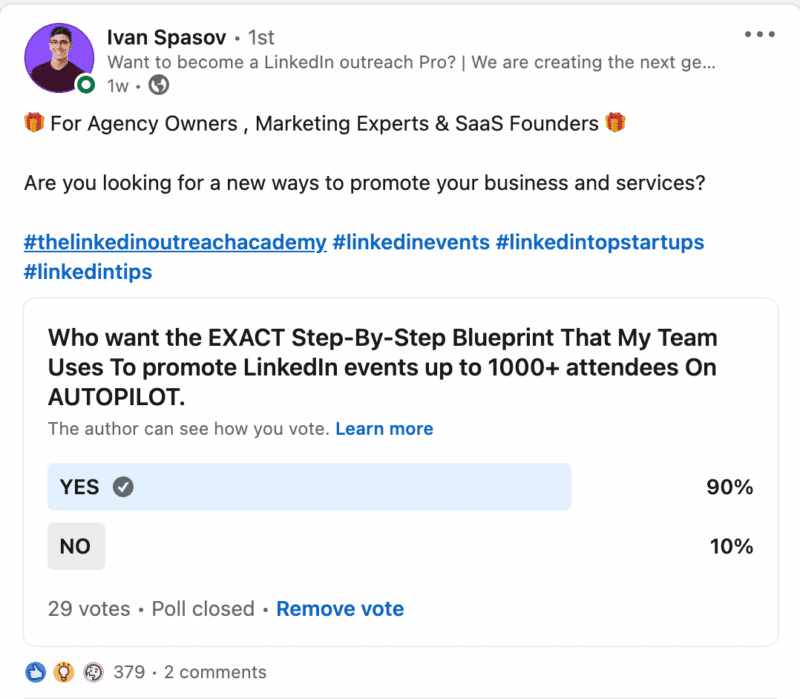
3. Define your success metrics
How do you know if your LinkedIn content marketing strategy is successful?
Yes, if you’re receiving a lot of likes and comments, chances are, your post was received well.
But if you want to scale your content production, you need to look beyond that and define what your success metrics look like.
While growth in sales is always going to be the most important metric, chances are, you can’t directly attribute a boost in sales to individual LinkedIn articles.
A B2B user journey might look like the following:
- A lead sees your post because their connection commented on it.
- They connect with you to see more of your posts.
- A few weeks later, they land on your company page because of a different LinkedIn post and subscribe to your email newsletter.
- They decide to get on a free discovery call and return to work with you a week after.
It’s hard to say what attributed to that sale, right?
This is why you need to measure your LinkedIn content’s success separately from your sales.
Some LinkedIn content metrics you should be keeping an eye on with the help of Linkedin analytics tools include:
- LinkedIn engagement rate
- Reach and post views
- Content impression
- Number of followers
- Video views
- Number of people who viewed your profile. Also your LinkedIn SEO
- Clicks, likes, comments, and shares
- LinkedIn SSI
Thankfully, LinkedIn makes it easy for your to track your post engagement as well as your analytics.
You can check this information under your company page and the Analytics section of your business page.

Here, LinkedIn will give you a personalized dashboard and graph to better understand your metrics over time.
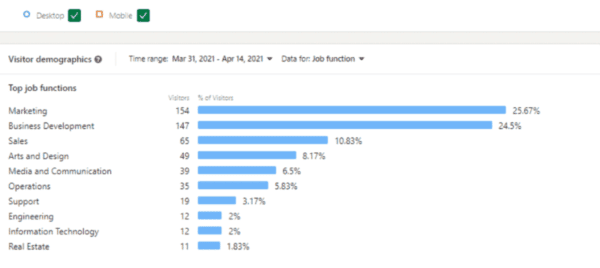
4. Outline your content strategy
A content strategy’s whole point is to know what to post and when.
You can also write posts for weeks in advance and schedule them for the future (see step #7 below).
And by outlining your content strategy, the idea is so that you’re never starting at a blank page again – unsure of what to post.
One possible content marketing strategy is the 40/40/20 framework. The content framework goes as follows:
- 40% Expertise posts – These posts provide value, educate your readers, and establish yourself as an authority figure. You should be giving away as much value as possible so that your leads see that you know what you’re talking about.
- 40% Engagement posts – These kinds of posts exist to boost your engagement and reach. Focus on maximizing your reach, likes, and comments here.
- 20% product, offers, and promotional posts – You should create relevant content based on your solution and the main problem you solve. This could be a case study, video content, a use case of your product or service, the outcome of your solution, social proof, and more.
At the same time, you shouldn’t restrict yourself in this framework too much.
If you have a new post idea that doesn’t fall into any of the above – you should still test it out and see how your audience reacts.
Now, the follow up question you might be wondering is – how often should I be posting on LinkedIn?
The answer might vary, depending on who you ask.
Hootsuite recommends posting at least once a day.
HubSpot notes that the return on investment drops substantially once you publish more than 5 times per week, the return on investment drops substantially. This is because LinkedIn doesn’t want its users to be overwhelmed by the number of posts by the same company.
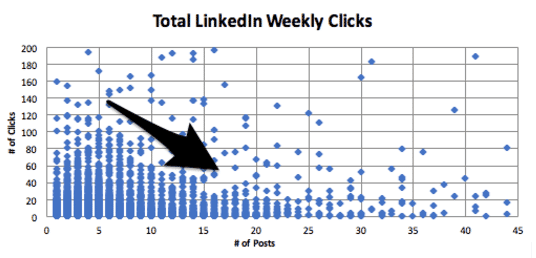
Though, the most important thing to note here is that it’s not about how often you’re posting, but rather, the type of content you’re creating.
Quality over quantity, as they say.
5. Follow the best LinkedIn post formatting and writing practices
When you’re creating a post, you should always try to look at it from the reader’s point of view.
Put yourself in their shoes.
Chances are, they’re scrolling LinkedIn, not looking for anything in particular.
They’ll only stop to read your post if they see something that stands out to them.
This is also why you see so many posts with GIFs, personal pictures, infographics, and more.
Another common strategy is the storytelling technique.
Because people don’t have a high attention span, you need to make it easy for them to spot your post and to keep their attention so they continue reading.
One common way LinkedIn influencers do this is by writing one sentence per paragraph. This way, the human eye naturally jumps to the next sentence to find out what happens next.
This is also much easier to read than a long essay of a post cramped together.
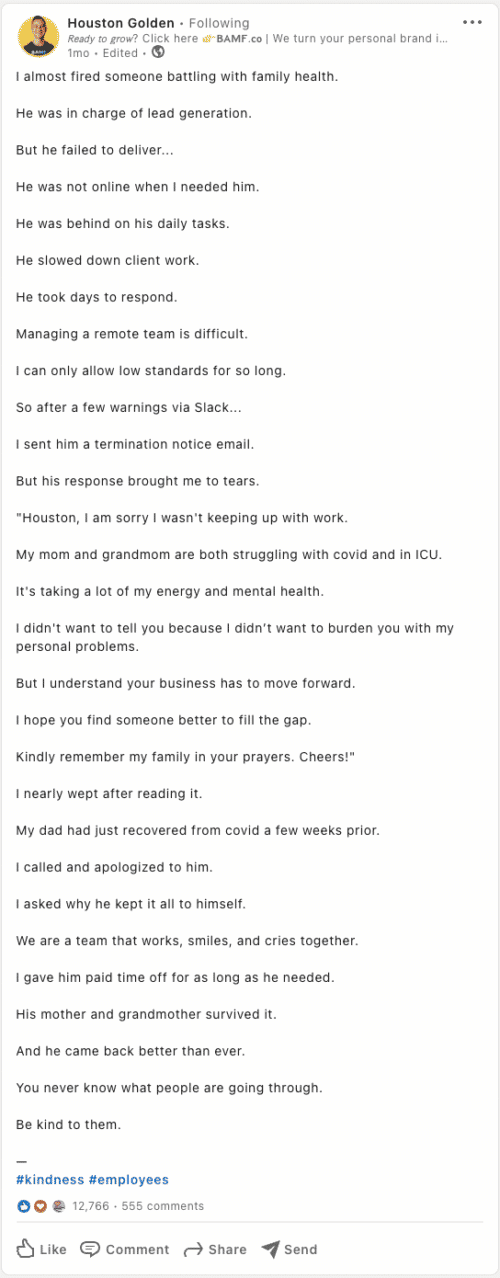
Some other ways you can format your LinkedIn articles and text posts so they stand out include:
- Using bold text.
- Using italics.
- Underlined text.
- Caps lock (or all capital letters).
- Emojis.
Then, to communicate your message, you’ll want to:
- Start with a strong hook to capture attention.
- Use the AIDA formula (attention, interest, desire, action) to keep their attention.
- Structure your paragraphs and use white space.
- Use emojis the right way.
- Write for your target audience (using the right pain points, needs, problems, etc.).
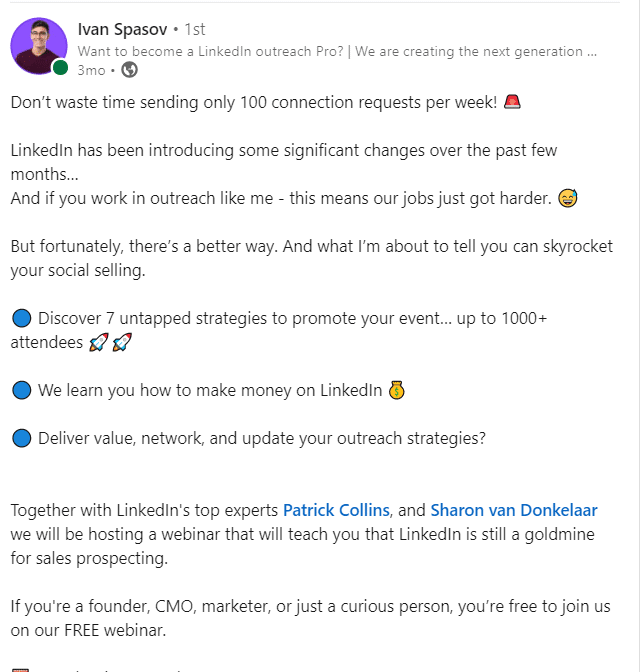
To learn how to do all that and more, see our full guide on formatting LinkedIn text posts.
6. Schedule your LinkedIn posts so they’re published automatically
Once you’ve defined your Linkedin content marketing strategy and written posts with the best formatting tips in mind, you’ll want to schedule them in advance.
The whole point is that you can write out your posts in Google Docs for weeks (or even months) ahead.
Then, you’ll want to schedule them so your posts get published automatically. Without you having to format and paste the text onto LinkedIn manually.
Now, unfortunately, LinkedIn doesn’t allow you to schedule posts natively within their platform.
However, you can simply use 3rd party social media marketing tool of your choice.
One popular choice is Hootsuite, which lets you schedule posts and view the analytics.
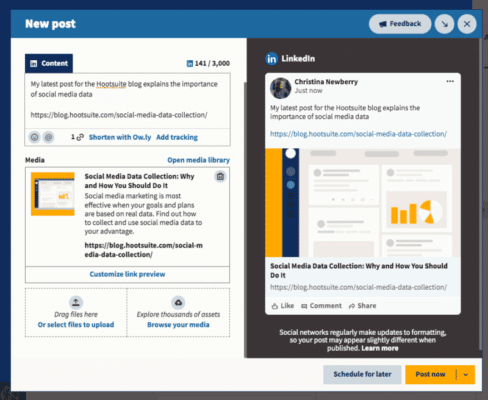
To schedule a post on LinkedIn this way, you need to:
- Connect your LinkedIn profile with a social media platforms posting tool
- Create a new post within the tool
- Select a social network, your post text, media, hashtags, and more
- Select a date and time
- Schedule your post on the calendar and analyze your post analytics to see what works afterward
If you’re wondering when you should schedule your posts for, according to Hootsuite, the best time to post on LinkedIn is around 9:00AM on Tuesdays and Wednesdays.
While you can schedule posts for the future, it’s still recommended that you always reply to and engage with people who comment under your posts.
For more information on this and other ways to use LinkedIn content for lead generation, see our full guide on scheduling posts on LinkedIn.
7. Measure content results and adjust your content strategy accordingly
Last but not least, one of the best ways to improve your content marketing strategy is by reviewing the analytics and making data-informed decisions based on what works and what doesn’t.
Though, when measuring your analytics, it’s important to measure your metrics across a longer timeframe.
For example, there’s no point in analyzing the metrics if you only posted a few times on LinkedIn as there won’t be enough data and sample size to make a well-informed decision.
Meanwhile, if you’ve been posting on LinkedIn for about a month, you’ll have a much better idea of the type of posts that perform better.
When looking at the bigger picture to decide whether or not your content strategy is successful, some of the most important metrics you should consider include:
- Number of followers and how quickly your page is growing.
- Impressions and how often your content appears in the news feed.
- Engagement rate and how often people are commenting or liking your posts.
- How many conversations you’re starting or how many leads are messaging you.
- Click-through rate and how often people are clicking your links to go to your website. You can even use Google Analytics to see where the traffic is coming from for this.
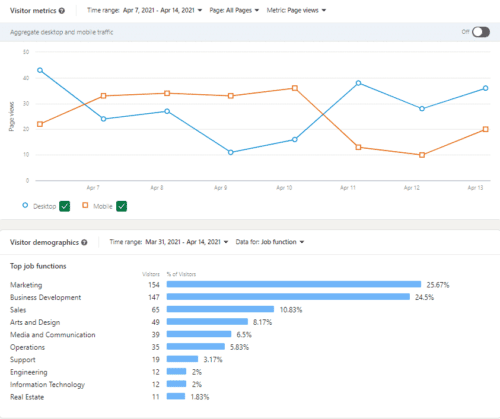
To recap, while analytics might seem confusing at first glance, the whole point here is to tell what works and what doesn’t based on data.
As you create more and more content, you’ll see what kind of posts get more engagement and love.
Now, let’s put all the above content tips and best practices together, and take a look at some examples of posts that work well.
10 LinkedIn Content Ideas And Examples To Swipe For Personal Branding
If you’re still not sure what type of content to create, let’s take a look at some real examples of LinkedIn posts with proven structures that everyone can use.
1. Storytelling technique
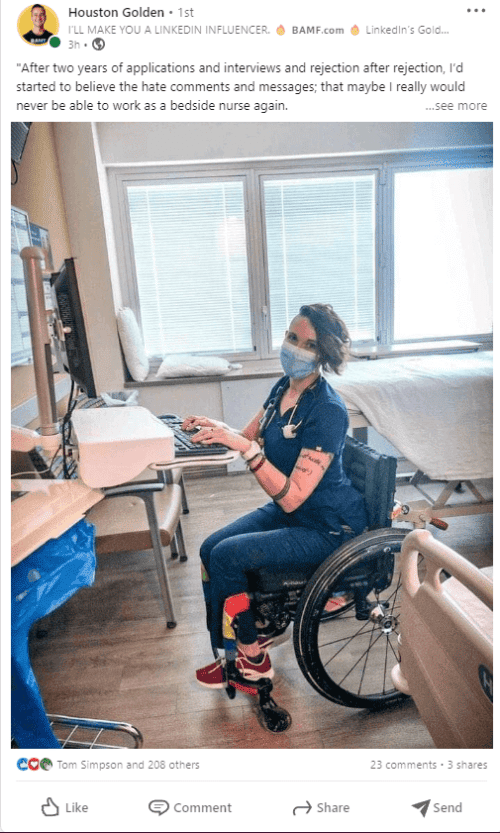
Storytelling is huge on LinkedIn.
Usually, this is one of the best ways to capture attention.
With a strong hook, the reader will want to click “See more” to continue reading.
And by starting on such a high note with an image that stands out, most people will want to find out how the story ends.
Starting with quotations also places the readers in the middle of the action and invested in what’s to come.
2. Engagement post tagging the right people
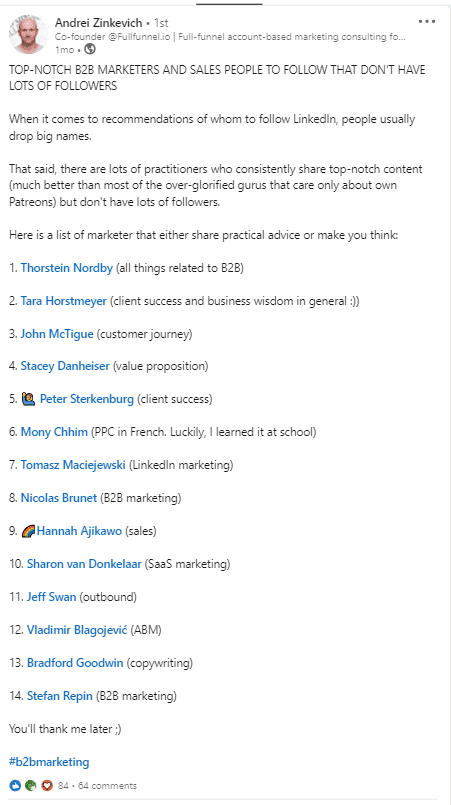
One simple way to increase your post engagement is to tag other people you think deserve more followers or produce quality content.
Ideally, your colleagues or people you know in the industry, not your competitors.
This has a strong reciprocity effect as the people you tag will either like, comment, or share your post. Or give you a shoutout under a separate post of theirs.
3. Comment and get it
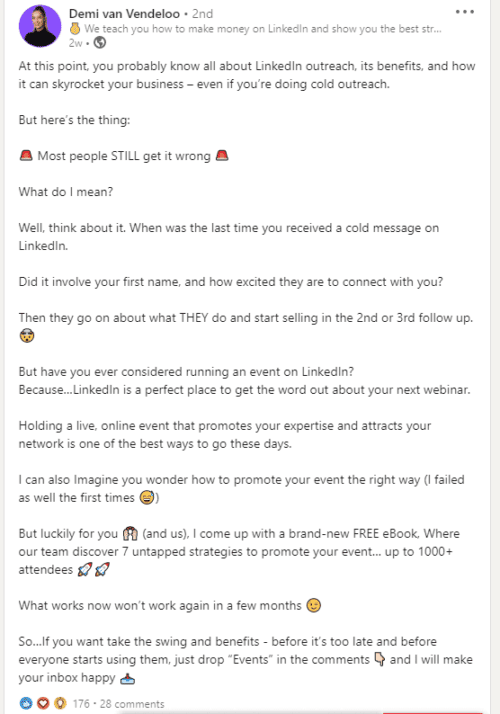
If you’re giving away something important that took you time and resources to make (e.g. lead magnet, webinar content, video content, etc.), you’ll want to do so with this technique.
Essentially, you create hype for something exciting you’re creating. Then, as a final call-to-action, end the post with “Comment X if you’re interested and I’ll send it over!”.
This incentives people to engage with your post. If your post receives a lot of likes and comments within the first 5-10 minutes, the LinkedIn algorithm will increase your reach even further.
This is how many posts go viral and people gain up to 500+ comments.
What if over 100 people comment on your post and you don’t want to message them one-by-one manually?
No problem! You can simply use a LinkedIn automation tool to scrape the list and automate your outreach.
4. Using LinkedIn polls for lead generation
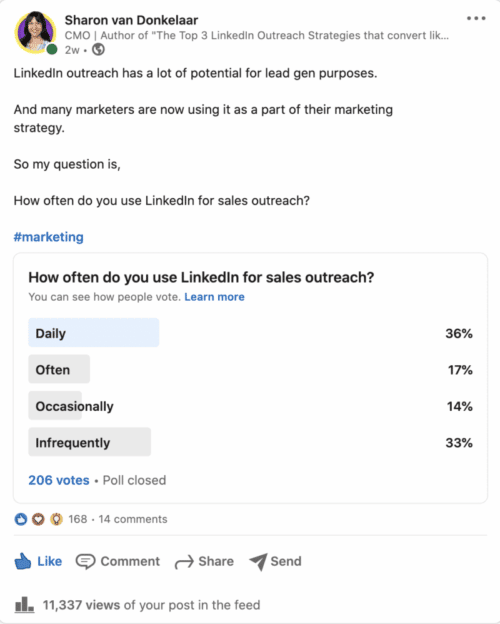
LinkedIn polls are becoming more and more popular. For a good reason too.
They usually have a much higher reach than regular text posts. This is because it’s much easier to vote on a quick poll than give a thought-provoking comment.
You can use this to your advantage and phrase your poll as a lead generation question (like in the above example).
Then, you can reach out to people who voted only for a specific option. For example, you can scrape the respondents who voted “Daily“, “Often“, and other options with a different template.
For example, with the above post, we could scrape the list of people who voted “Infrequently” and reach out to ask about their pain points to educate them about using LinkedIn for sales outreach.
For more information on how to scrape polls, see our full guide on LinkedIn polls.
5. Share valuable content
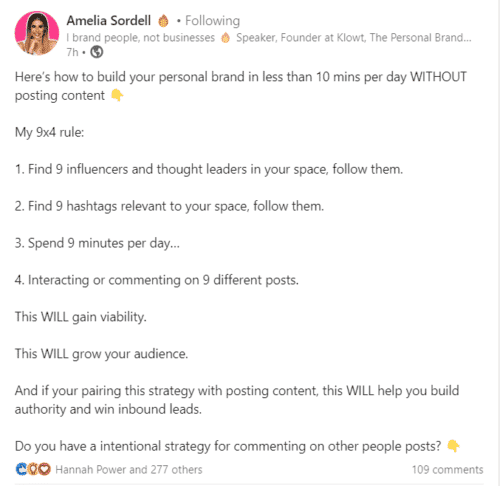
This is probably one of the most straightforward content structures.
But as long as you share valuable, actionable content, people will keep coming back for more!
This is what positions you as an authority figure in your industry.
Just remember to be specific when sharing valuable content.
6. Case studies
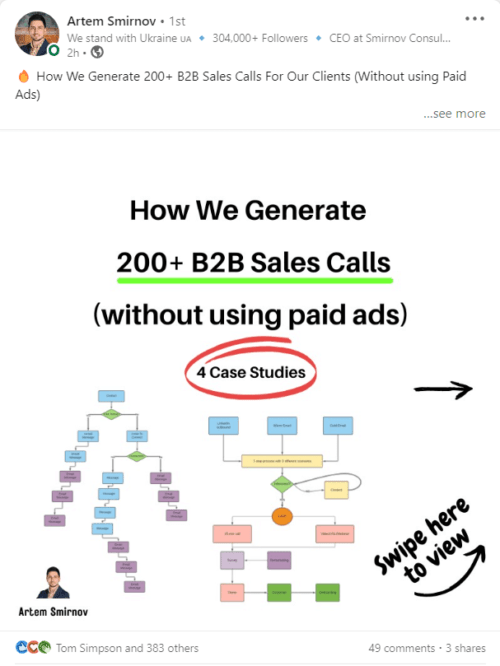
As we covered in the content strategy framework above, case studies fall under “promotional posts“.
Because, essentially, you’re showing off your brand and how you achieved certain results for your clients.
This gives your leads a reason to work with you.
While this can generate decent engagement, usually, it’s more self-promotional in nature and might disconnect certain people.
7. Share other peoples’ content

When sharing other peoples’ content, you’re shining a light on them and telling your network to follow that person as well.
Why would you want to do this?
Sharing content also plays into reciprocity, that we discussed above. And the person whose content you shared might be more likely to want to develop a win-win relationship with you.
They might share your content back at some point or give you a shoutout later.
8. Generate discussion
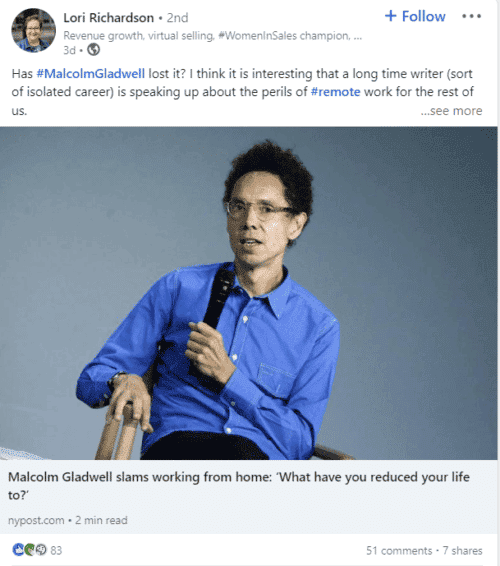
This one is simple!
You don’t even have to write a lot of content yourself.
Simply look into what’s going on in the world and ask questions.
See if your network agrees, disagrees, or has thoughts.
Obviously, it shouldn’t be something too controversial that has no place on LinkedIn.
But as long as it’s related to your industry and you have an opinion on it, chances are, other people might have as well!
9. Be authentic and personal
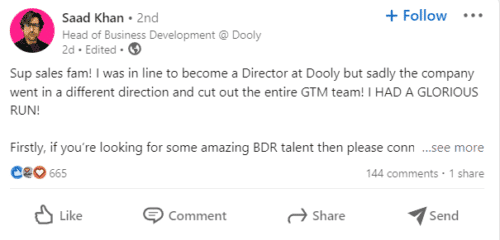
Showing a personal, transparent side of you on LinkedIn is a great way to connect with others and stand out.
Whether you’re starting a new position or going in a different direction, consider updating your network on LinkedIn.
People follow and engage with people they like first and foremost.
Instead of being a faceless brand, this is a great way to shine through your personality.
This, in turn, will make you more memorable and more likely for people to engage with your content.
10. Share your lessons learned
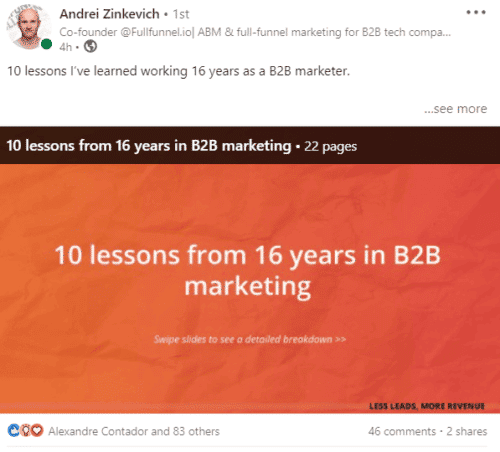
Last but not least, another content structure is the “lessons learned” format.
And what makes this so great is that it can be applied to everyone.
Whether it’s seasoned business owners or people just starting out.
If your experience resonates with other people (which it should), your content should gather some form of engagement.
Conclusion
And that’s a wrap!
Hope this guide to LinkedIn content strategy was helpful!
We covered quite a lot above.
So, let’s recap briefly.
-
- More than 55% of decision-makers use LinkedIn content to vet organizations they want to work with. LinkedIn is the go-to channel for most B2B marketers and brands.
- The benefits of posting content on LinkedIn have to do with the reach. With over 61M senior-level influencers and 40M decision-makers on the platform, content is a great way to reach and engage your target audience.
- Finally, to boost your B2B sales, you’ll want to post relevant content consistently. For this, you need to create the right content strategy, based on your brand. With it, you can then start scheduling posts for weeks in advance so that your lead generation works for you.
Finally, another important part of doing LinkedIn content marketing has to do with outreach.
Whether you want to reach out to the 50+ people who commented on your post, follow up with everyone who said they wanted to attend your webinar, or connect with potential prospects who don’t know about your brand yet.
The best way to do this is through automated LinkedIn outreach.
For more info on that, request a demo for a free, 7-day Expandi trial now!
Or alternatively, if you need more info on getting the most out of your LinkedIn content strategy, join our private Facebook group The LinkedIn Outreach Family. In it, you can ask even more specific questions or engage with other business owners who are successfully generating sales with content on LinkedIn!
You’ve made it all the way down here, take the final step

